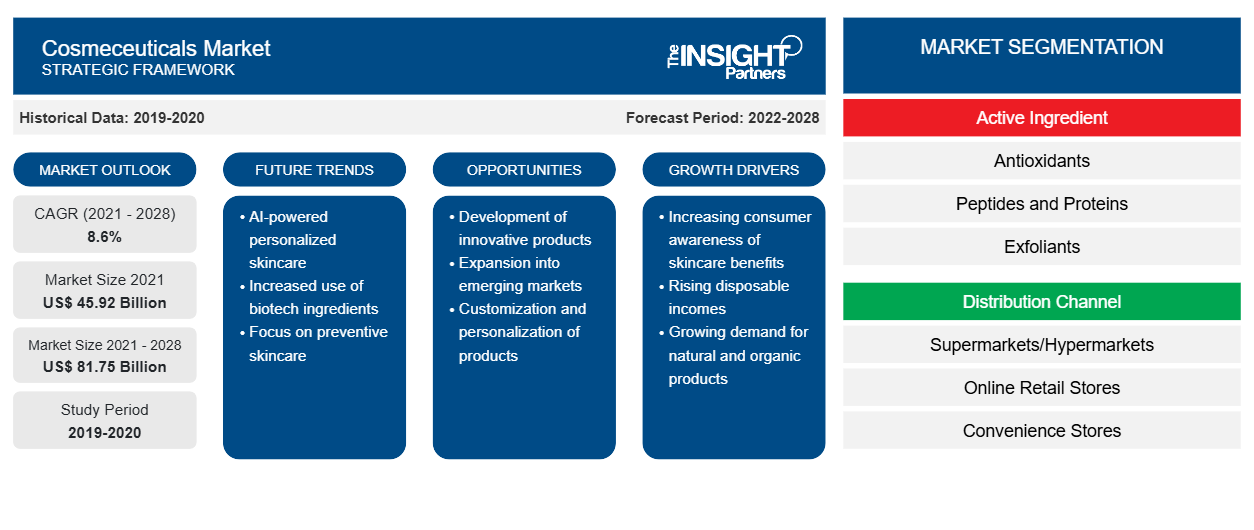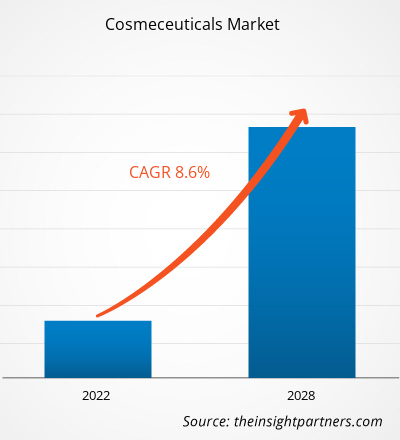[Research Report] The cosmeceuticals market size is expected to grow from US$ 45,916.66 million in 2021 to US$ 81,753.36 million by 2028; it is estimated to record a CAGR of 8.6% from 2021 to 2028.
Analyst Perspective
The Cosmeceuticals market implies to a segment within the cosmetics industry that combines products with pharmaceuticals properties. These products bridge the gap between traditional cosmetics and pharmaceuticals by offering more targeted and scientifically advanced formulations. The cosmeceuticals market is driven by factors such as increasing consumer awareness about personal appearance, rising disposable incomes, and growing demand for anti-aging and skin care products. Advances in technology and research have also contributed to the development of innovative cosmeceutical products. The product category within the cosmeceutical market includes skin care, hair care, oral care, sunscreens are among the most popular in this segments. Hair care products focus on improving hair health, addressing issues like hair loss, dandruff. Oral care cosmeceuticals include toothpaste, mouthwash, and other products that promote oral health. Cosmeceuticals products are primarily distributed through various channels such as retail stores, speciality outlets, e-commerce platforms have played a significant role in expanding the market growth and accessibility of cosmeceuticals.
Market Overview
Cosmeceuticals are cosmetic products that contain bioactive ingredients with potential pharmaceuticals properties. Cosmeceuticals are designed to provide cosmetic benefits while also targeting specific skin or hair concerns, offering more than just aesthetic improvements. The distinction between cosmeceuticals and regular cosmetic lies in the ingredients that have been scientifically researched and proven to provide specific benefits to the skin and hair. These ingredients may include antioxidants, peptides, vitamins, retinoids, hyaluronic acid, botanical extracts, and other bioactive substances. The cosmeceuticals market has seen significant growth as consumers increasingly seek products that provide both cosmetic and skin or hair health benefits. The cosmeceuticals market is highly competitive, with several major players and numerous smaller companies operating globally. The companies invest heavily in research and development to introduce innovative cosmeceuticals products and maintain a competitive edge. The cosmeceuticals market is driven by innovation, scientific advancements, and evolving consumer preferences, creating opportunities for both established players and new entrants.
Customize This Report To Suit Your Requirement
You will get customization on any report - free of charge - including parts of this report, or country-level analysis, Excel Data pack, as well as avail great offers and discounts for start-ups & universities
Cosmeceuticals Market: Strategic Insights

-
Get Top Key Market Trends of this report.This FREE sample will include data analysis, ranging from market trends to estimates and forecasts.
Market Driver
Development Opportunities in Emerging Countries to Drive market Growth
The emerging markets in regions such as the Middle East, Africa, and Asia Pacific are creating significant opportunities for the key market players to expand their businesses. The majority of players concentrate on developing markets, such as India and China, owing to the large population suffering from chronic diseases in these countries. With rising production costs against their practices, the healthcare companies are striving to produce sufficient revenue to entertain their investors. The markets in a few growing economies are expected to be an essential part of offering more reliable and profitable growth opportunities for the major players to expand their industry and geographic scope.
Advancements in biotechnology have increased the demand for cosmeceuticals, encouraging the introduction of more customized products and facilitating the shift toward personalized cosmeceuticals. Various players in the industry have been investing a significant amount of their revenue in R&D activities to develop better and advanced products and technologies to be used in the Cosmeceuticals market. The Asia Pacific market is anticipated to have the fastest growth during the forecast period due to the presence of significant biopharmaceutical companies in countries such as Japan and the growing number of local companies in countries such as China and India. These activities in the region are increasing the demand for cosmeceuticals in the region and is anticipated to provide significant growth opportunities to the players operating in the cosmeceuticals market during the forecast period. Thus, the factors mentioned above are driving the cosmeceuticals market during the forecast period.
Segmental Analysis
Based on products, the cosmeceuticals market is categorized into skin care, hair care, oral care, and others. In 2021, the skin care segment is likely to hold the largest share of the cosmeceuticals market. Moreover, the same segment is also expected to witness growth in its demand at a fastest CAGR in cosmeceuticals market during 2021 to 2028, owing to the increasing demand of sunscreens in tropical countries and anti-ageing products across the globe. The growing prevalence of skin-related problems has propelled the growth of skin care segment in the cosmeceuticals market. Use of skincare products has increased due to climate change and its impact on the skin. The growing number of industries has resulted in higher levels of pollution in cities, which may have negative effects on the skin, prompting individuals to seek more skincare products for protection. UV protection is extensively advocated and emphasized by dermatologists, cosmetologists and other experts as one of the most critical skincare requirements. Consumers are increasingly aware that they must protect themselves not just from UV rays, but also from blue light, smoking, smog, pollution, germs, bacteria and viruses. As a result, manufacturers must focus on more specialized sunscreens, blue light protection therapies, antioxidant serums and antimicrobial product innovations. For instance, In Jan 2023, Oriflame launched a cosmeceutical range to expand skincare offerings. Oriflame expanded its skincare offering to the Indian market and launched its first range of ‘cosmeceutical’ products named ‘NovAge Proceuticals’. The cosmetics and beauty business’ new line is designed to address its customers’ specific skin challenges. Thus, the factors mentioned above are driving the skin care segment in cosmeceuticals market during the forecast period.
Regional Analysis
The North America cosmeceuticals market was valued at US$ 12,918.33 million in 2021 and is projected to reach US$ 23,275.18 million by 2028; it is expected to grow at a CAGR of 8.8% during the forecast period. The North America cosmeceuticals market is segmented into the US, Canada and Mexico. The United States held the largest market in North America for cosmeceuticals, and the cosmeceuticals market is expected to grow due to increasing demand of anti-ageing products and increased adoption of online and e-commerce buying structure for cosmeceuticals. The trend of awareness related to skin, hair, and oral hygiene for health purpose, represents an unprecedented opportunity for improving public health in the country. These increasingly powerful services are proving to be a lifeline for people who need improved access to health services, which will fuel the growth of cosmeceuticals market.
Moreover, consumers are trying new products and are interacting with brands in new ways, which has been made possible due to the emergence of beauty vloggers, who share YouTube tutorials and Instagram stories about their favorite face creams, lipsticks, mascara, compact powder, etc. Many cosmeceutical companies have begun to abandon conventional ads and prefer hiring big faces and influencers for promoting their brands to target customers. Therefore, the US cosmeceuticals market has experienced a boom in the demand for cosmetic products in the historical period. Thus, above mentioned factors are expected to propel the cosmeceuticals market growth in the region.
Key Player Analysis
The cosmeceuticals market analysis consists of players, such as as L'Oreal S.A., Beiersdorf Global, Croda International, Amway Corp., Allergan, Unilever PLC, Johnson & Johnson, Procter & Gamble, Avon Products Inc., and BASF SE, among others are the top two players owing to the diversified product portfolio offered.
Cosmeceuticals Market Regional InsightsThe regional trends and factors influencing the Cosmeceuticals Market throughout the forecast period have been thoroughly explained by the analysts at The Insight Partners. This section also discusses Cosmeceuticals Market segments and geography across North America, Europe, Asia Pacific, Middle East and Africa, and South and Central America.
Cosmeceuticals Market Report Scope
| Report Attribute | Details |
|---|---|
| Market size in 2021 | US$ 45.92 Billion |
| Market Size by 2028 | US$ 81.75 Billion |
| Global CAGR (2021 - 2028) | 8.6% |
| Historical Data | 2019-2020 |
| Forecast period | 2022-2028 |
| Segments Covered |
By Active Ingredient
|
| Regions and Countries Covered |
North America
|
| Market leaders and key company profiles |
|
Cosmeceuticals Market Players Density: Understanding Its Impact on Business Dynamics
The Cosmeceuticals Market is growing rapidly, driven by increasing end-user demand due to factors such as evolving consumer preferences, technological advancements, and greater awareness of the product's benefits. As demand rises, businesses are expanding their offerings, innovating to meet consumer needs, and capitalizing on emerging trends, which further fuels market growth.

- Get the Cosmeceuticals Market top key players overview
Recent Developments
Inorganic and organic strategies such as mergers and acquisitions are highly adopted by companies in the cosmeceuticals market. A few recent key market developments in the cosmeceuticals market are listed below:
- In Aug 2021, Shiseido Company, Limited announced a framework agreement between its China subsidiary, Shiseido China Co., Ltd., and Boyu Capital to launch the Shiseido Beauty Innovations Fund. The operation of the Fund will be conducted by Boyu and Shiseido and is scheduled to start this year after completion of relevant regulatory filings in China. The Fund will explore investment opportunities among China’s emerging brands in cosmetics and wellness, as well as in related technology companies such as e-commerce services and consumer experience technology.
- In Jul 2021, L'Oreal Groupe launched its first ever TikTok beauty channel driven by a progressive vision of the beauty industry's future, the channel uncovers the group's science, innovations and technologies beyond the world's favorite beauty products. Working in collaboration with experts from L'Oreal, this new channel delivers content that combines science, innovation, tech behind beauty products.
Frequently Asked Questions
What are the driving factors for the cosmeceuticals market across the country?
Which segment is dominating the cosmeceuticals market?
What is the cosmeceuticals market?
Who are the major players in the cosmeceuticals market?
- Historical Analysis (2 Years), Base Year, Forecast (7 Years) with CAGR
- PEST and SWOT Analysis
- Market Size Value / Volume - Global, Regional, Country
- Industry and Competitive Landscape
- Excel Dataset
Recent Reports
Testimonials
Reason to Buy
- Informed Decision-Making
- Understanding Market Dynamics
- Competitive Analysis
- Identifying Emerging Markets
- Customer Insights
- Market Forecasts
- Risk Mitigation
- Boosting Operational Efficiency
- Strategic Planning
- Investment Justification
- Tracking Industry Innovations
- Aligning with Regulatory Trends





















 Get Free Sample For
Get Free Sample For